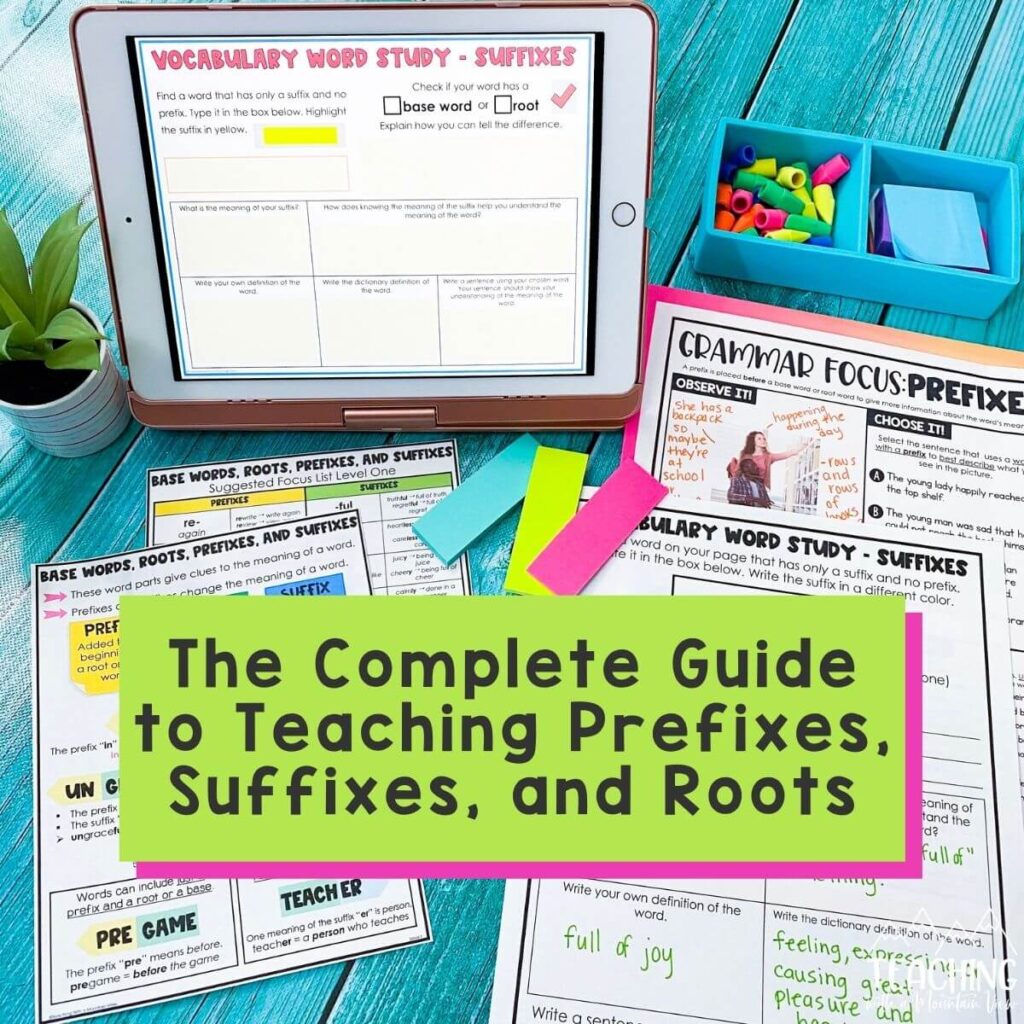
Teaching spelling to upper elementary students can be somewhat of a head scratcher. When I was in school, we were given spelling books. Each week, we would be required to memorize a list of words, complete activities, and then pass a spelling test at the end of the week. There was pretty much zero spelling strategy instruction.
It shouldn’t be a surprise that wasn’t the most effective way to teach spelling, but it took some time to unlearn that strategy when I first began teaching. Spelling academic and grade-level vocabulary words is often a part of the upper elementary standards, and now with the heavy focus on implementing The Science of Reading (YAY!), it’s important to really consider how you’ve been teaching spelling all of these years – spoiler alert: lists aren’t best practice! Students should be analyzing word parts, linking graphemes to phonemes, and be explicitly taught spelling.
So, exactly how do you meet this standard without memorizing word lists? Here are four spelling strategies to use in your classroom.

Spelling Strategy #1: Spelling Patterns
When I say spelling patterns, what comes to mind? Some of us may have been taught these rules or learned them as educators. Others of us may be still trying to figure out what a long vs. short vowel is (no shame, I was that person!).
Spelling patterns are the general rules that apply spelling. Growing up, you may have been taught little phrases to help you remember certain spelling patterns. Things like, “drop the y and add ies” or “i before e, except after c”. These sayings help you remember spelling pattern rules, and it’s exactly what will also help your students spell more easily.
When you start teaching spelling patterns to students, I first recommend looking at your grade-level stands. There may be suggested spelling patterns for your grade-level. If not, or if your students seem behind, take a look at the Reading Rockets spelling pattern list. Determine a few spelling patterns to start with.
After you have spelling patterns in mind, begin practicing these patterns using some of the following strategies:
- Have students sort out words based on a spelling pattern (ex. soft vs hard c).
- When reading in class, pull out in-context vocabulary that applies to a spelling rule. Have students identify what spelling pattern is present.
- Give students a misspelled word. Have them use a known word pattern to correct the spelling.
Spelling Strategy #2: Word Parts
Another strategy for teaching spelling is word parts. Many words are made of word parts, such as prefixes, roots and suffixes. By understanding different word parts, students not only become better spellers, but also have a better understanding of unfamiliar words.
There are many different word parts out there, and again, you may find that your state standards list different word parts they expect students to know in a given grade level. If not, you can find many word part resources online to help you identify appropriate ones for your students. Literary in Focus has a great blog post with a list of different word parts to get you started.
After you know different word parts you would like to teach, here are a few strategies for teaching spelling:
- Ask your students to write as many words as they know with a specific root, suffix, or prefix. (You will also have students give you words that they think include the word part, which is a great opportunity to help them learn a new spelling rule!)
- Give your students a short list of words that utilize a specific word part, along with the word’s meaning. Then, have your students write these words into sentences, or place them in fill-in-the-blank sentences.
- Give students a list of words with a specific word part. Have students identify the root, prefix, or suffix and note its meaning.
I also shared more information in this complete guide to teaching roots, prefixes, and suffixes here.
Spelling Strategy #3: Dictionary Skills
With online dictionaries, it may seem like dictionary skills are a wasted skill. However, whether students are utilizing online or paper dictionaries, they still need to understand how to use them.
The biggest issue I run into students can seem a little counterproductive. Students will say, “How can I look up the word if I don’t know how to spell it?” They have a good point! This is where practicing the first spelling patterns and word parts with students will come in handy.
When looking items up in the dictionary, we want to remind students to first rely on the patterns and word parts they already know to spell a word as correctly as possible. Next, they should remove any prefixes or suffixes. Then, they can begin their search.
Here are a few ways you can practice dictionary skills with students:
- During class or using a recording in stations, have students listen to a word and then locate the spelling in a dictionary.
- Dictionary races! Write a word down on the board, and have students work as quickly as they can to locate it in the dictionary (this mostly helps with students get familiar with dictionary usage and using the guidewords).
- Have students complete a dictionary scavenger hunt. Ask them to search for a noun, word that ends in e, word that starts with d, etc.
Spelling Strategy #4: Commonly Confused Words
Lastly, students should practice commonly confused words, otherwise known as homophones, homonyms, and homographs. I wrote a post previously about teaching commonly confused words, and you can read that in-depth guide here!
Essentially, commonly confused words, typically homophones, can create spelling issues because when students are not aware of a word’s meaning or that it has different spellings. Therefore, they may choose the wrong word. A common example (that drives many teachers nuts) is their/there/they’re. By understanding these commonly confused words, students can have more success in choosing the correct word – therefore spelling it right!
Here are a few activities to practice commonly confused words:
- Give students several fill-in-the-blank sentences, and have them place the right homophone.
- Play a game of heads up. Give students a notecard to hold to their forehead. Have students give each other hints to guess their word. For example: I am pronounced “there” and I mean a place in another location.
Teaching spelling can feel like an awfully full topic! Avoid the overwhelm though by coming up with a plan. You can incorporate these strategies into your morning work, word study, warm-ups, centers, or independent work. You don’t have to spend a lot of your direct teaching time explaining spelling rules, so find an easy place to slip it into your day!
Mary Montero
I’m so glad you are here. I’m a current gifted and talented teacher in a small town in Colorado, and I’ve been in education since 2009. My passion (other than my family and cookies) is for making teachers’ lives easier and classrooms more engaging.












